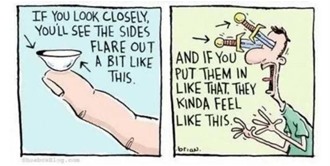Contact lenses being thin and flexible can easily turn inside out, the good news is this will not cause damage to the eye and often an inside out contact lens often doesn’t affect your vision but it can cause discomfort that some people notice straight away and others take a few days before they realize somethings wrong.
Contact lenses have a curvature that fits the surface of the eye, if the lens is inside out you will probably experience the lens moving around, the lens edges may cause discomfort, the eyes will become watery and when you blink the lens may fold and pop out, this is as bad as it gets.
If you are wearing daily lenses then I have good news for you, you can take advantage of the way the contact lens is packaged in its sealed vial, as manufacturers always place the lens the correctly, so if you can keep this orientation when inserting the lens you can’t go wrong.
For two weekly and monthly contact lenses that are inserted, removed, cleaned and stored multiple times the probability of the lens turning inside out is much higher, below are some easy tips to help you check ;
Mixing Bowl / Saucer
Perch the contact lens on your finger and look at it from the side, the shape should resemble a mixing bowl with straight sides, if the sides are flopping outwards resembling a saucer, it’s inside out.
Taco Test
Gently pinch the lens between your thumb and forefinger, if the shape looks like a taco shell you’ve got it the right way round, if it looks more like a spoon it’s inside out.
1-2-3 Stamp on the Lens
Some contact lenses have 123 stamped on to the lens, different manufacturers place these numbers in different places and often you will need to look quite closely to see them. When you’ve found them they need to be order ; 1-2-3 if the numbers are backwards your lens is inside out.
Visability Tint
A visibility tint has been added to some lenses, this doesn’t add colour to your eyes it’s simply an aid that enables you to find the lens easily in the storage vial, also when balanced on top of the finger prior to insertion you should see a tinted edge, if you don’t see a tinted edge the lens is inside out.
You don’t need to be a newbie to put your contact lenses on inside out, it happens to the best of us especially if you're in a rush ! However, with experience you get to know what you are looking for and will know straight away if you’ve got it wrong.

